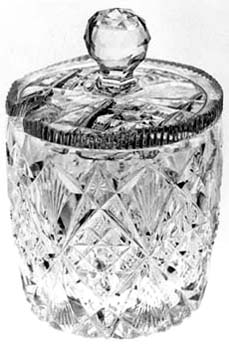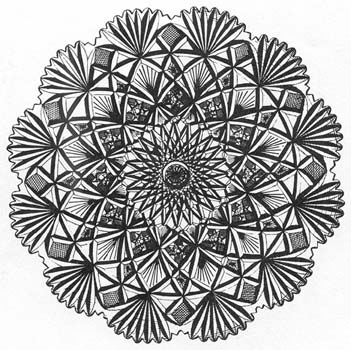

At times a cut-glass designer might wish to create a pattern that is vertically symmetrical in addition to being horizontally symmetrical. For example, if there is a need to apply it to a fairly small object, a pattern that lacks vertical symmetry could appear unbalanced, perhaps even top-heavy. A transformation is called for and can be accomplished by placing the principle motif -- a chain of hobstars, for example -- in the center of the design and framing it with the miter cuts and motifs that are found in the pattern's original configuration. Descriptive words fail the writer at this point; it is best for him, and the reader(!), that he illustrate this process -- which involves selecting only a part of an entire pattern -- by discussing actual examples from the Hawkes catalog:
(1) The all-glass mustard jar, below on the left, has been cut in a vertically symmetrical version of Hawkes' patented Brazilian pattern whose patent drawing is illustrated on the right. To accomplish this it was necessary to use only that portion of the complete pattern that lies within the circular miter cut on the patent's drawing. Simplicity itself. The pattern is, of course, still identified as Brazilian. Hawkes obviously intended that more than one version of his Brazilian pattern be produced because, in addition to the complete pattern, his patent also illustrates a version that contains only a portion of it -- one that eliminates the chain of hobstars -- as cut on a dish and on a wine glass. The mustard jar uses a different portion of the complete pattern, one that includes the chain of hobstars.
LEFT: Mustard jar, shape no. 544, with a height of 4" (10.2 cm). Its slotted cover is cut in-pattern. The jar was offered for sale as-found, with some small chips. It sold for $115 in 1989. RIGHT: The complete Brazilian pattern of 1889 as found in the letters patent (pat. no. 19,114).


Incidentally, many mustard jars are available today, but the majority of them have been produced on "figured" blanks, and some are foreign imports. This elaborate Hawkes example was cut on a plain blank -- as one would expect from this company -- and is a quality product.
(2) The second example uses Hawkes' Portland pattern (c1902). The transformation, which is slightly more complex than in the case of the Brazilian pattern, is demonstrated by the following illustrations of a plate, which shows the complete pattern -- together with a close-up -- and a vase with the pattern transformed.
Two images of a plate, signed Hawkes, cut in the company's Portland pattern. The plate has a diameter of 7" (17.8 cm) and was sold at an eBay auction for $178 in 2004 (Images: Internet).


To transform this pattern into one that is vertically symmetrical for use on the vase, below, the interior chain of hobstars is placed around the center of the vase, the outer chain eliminated, and other miter cuts are arranged in the same configuration that was used in the Brazilian example. The only addition to the original pattern, as shown on the plate, are the small, four-sided figures that contain single stars, also present on the Brazilian transformation. In fact the transformed Brazilian pattern can be thought of as a template for the transformed Portland pattern, where the fans have been replaced with strawberry (fine) diamonds and the hobstars rotated.
Incidentally, the 8-pt hobstars are actually the so-called Middlesex-type hobstars, but they are greatly distorted on the plate. The pattern there has two ranks of these hobstars. The Middlesex hobstars on the interior chain are so small and so confined that they are mere travesties. (Hawkes seems to have begun using hobstars with points that are incomplete as early as the mid 1890s; they appear in the drawing that accompanies his patent for the Aberdeen pattern, pat. no. 25,386 of 1897).
The vase is signed Hawkes and has been cut on blank no. 1065. This blank is a "footed vase" according to the Hawkes archives (CMG), but it is sometimes erroneously referred to as a "pedestalled rose bowl" or a "rose bowl on a standard" by dealers and collectors. Blank no. 1065, which was first recorded on 12 Apr 1898, was available in four heights: 4", 5", 6", and 7" (Spillman 1996, p. 123). Colorless here, it can also be found cased in color, as illustrated on the dust jacket of Pearson and Pearson (1969). H = 7.0" (17.8 cm), max D = 5.5" (14.0 cm). Signed Hawkes. Turn of the twentieth century. Sold at an eBay auction for $521 in 2002 (Image: Internet).

It is important to keep vertically symmetrical versions of familiar patterns in mind when one is attempting to identify an unknown pattern. For example, consider a jar in the White House collection. It is small, only about the size of the mustard jar (Spillman 1989, pp. 116-7). Its pattern is not identified in Spillman's book, but the reader should now be in a position to recognize it as the vertically symmetrical version of Hawkes' Devonshire pattern. The jar's silver mount is dated 1901 (note 1).
An example of a more elusive identification of a transformed pattern is provided by a humidor that is illustrated in Spillman's book on Corning cut glass (1996, p. 195). Had the author not informed her readers, it is likely that few would recognize the humidor's pattern as Cobweb, because all of the cobwebs have been swept away!
Transformations similar to the examples considered in this file can, of course, be found among patterns cut by other manufacturers: Clark's Henry VIII and Dorflinger's Marlboro are two likely candidates.
NOTE:
1. The vertically symmetrical version of the Devonshire pattern is also shown, on a ladle's handle, in the GRAND PRIZE, PARIS EXPOSITION catalog. ACGA, [1989], p. 193.
Updated 27 Apr 2004